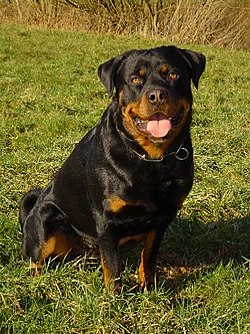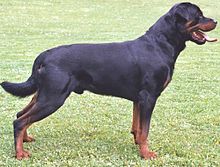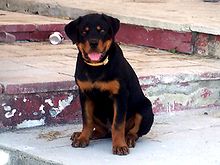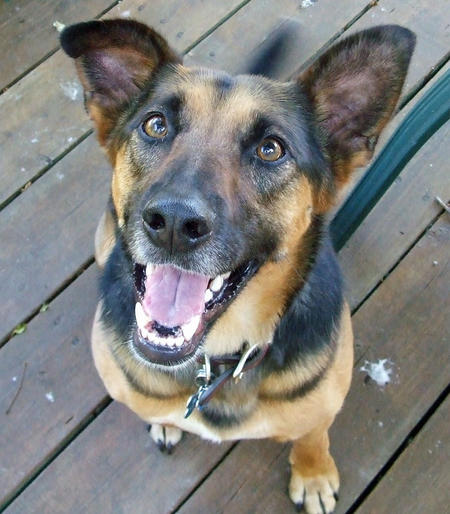This article is about the dog breed. For other uses, see Rottweiler (disambiguation).
 | ||||||||||||||||||||||||||||
| Nicknames | Rottie Rott | |||||||||||||||||||||||||||
|---|---|---|---|---|---|---|---|---|---|---|---|---|---|---|---|---|---|---|---|---|---|---|---|---|---|---|---|---|
| Country of origin | Germany | |||||||||||||||||||||||||||
| ||||||||||||||||||||||||||||
| ||||||||||||||||||||||||||||
| Dog (Canis lupus familiaris) | ||||||||||||||||||||||||||||
The Rottweiler was employed in these traditional roles until the mid-19th century when railroads replaced droving for getting livestock to market. While still used in herding, Rottweilers are now also used in search and rescue, as guide dogs for the blind, as guard or police dogs, and in other roles.[2]
Contents[hide] |
[edit] History

Rottweiler memorial in Rottweil, Germany
The breed is ancient, one whose history stretches back to the Roman Empire. In those times, the legions traveled with their meat on the hoof and required the assistance of working dogs to herd the cattle. One route the army traveled was through Württemberg and on to the small market town of Rottweil. The principal ancestors of the first Rottweilers during this time are believed to be the Roman droving dog, local dogs the army met on its travels, and dogs with molosser appearance coming from England and The Netherlands.
This region was eventually to become an important cattle area, and the descendants of the Roman cattle dogs proved their worth in both driving and protecting the cattle from robbers and wild animals. Rottweilers were said to have been used by travelling butchers at markets during the Middle Ages to guard money pouches tied around their necks.[4] However, by the end of the 19th century as railroads became the main method for moving stock to market, the breed had declined so much that in 1900 there was only one female to be found in the town of Rottweil.
The build up to World War I saw a great demand for police dogs, and that led to a revival of interest in the Rottweiler. During the First and Second World Wars, Rottweilers were put into service in various roles including as messenger, ambulance, draught, and guard dogs.
The first Rottweiler club in Germany, named DRK ("Deutscher Rottweiler-Klub" — German Rottweiler Club) was created the 13 January 1907, and followed by the creation of the SDRK ("Süddeutscher Rottweiler-Klub" — South German Rottweiler Club) on the 27 April 1907 and became the IRK (International Rottweiler Club). The DRK counted around 500 Rottweiler, the SDRK 3000 Rottweilers. The goals of the two clubs were different. The DRK wanted to produce working dogs and did not emphasize the morphology of the Rottweiler. The main stud dog of this club was Lord von der Teck. The IRK tried to produce a homogeneous morphology according to their standard. One of the main stud dogs of this club was Ralph von Neckar.
The various German Rottweiler Clubs amalgamated to form the German General Rottweiler Club (Allgemeiner Deutscher Rottweiler Klub - e.V) usually known by its German Initials as "the ADRK," in 1921. This was officially recorded in the register of clubs and associations at the district court of Stuttgart on January 27, 1924.[5] The ADRK is recognised worldwide as the home club of the Rottweiler.
In 1935 the Rottweiler was officially recognized by the American Kennel Club. In 1936, Rottweilers were exhibited in Britain at Crufts. In 1966, a separate register was opened for the breed. In fact, in the mid 1990s, the popularity of the Rottweiler reached an all time high with it being the 1st most registered dog by the American Kennel Club.[6]
[edit] Description
"Rottweiler breeders aim at a dog of abundant strength, black coated with clearly defined rich tan markings, whose powerful appearance does not lack nobility and which is exceptionally well suited to being a companion, service and working dog."[7]- Head (eyes)
- Snout (teeth, tongue)
- Dewlap (throat, neck skin)
- Shoulder
- Elbow
- Forefeet
- Highest Point of the Rump
- Leg (thigh and hip)
- Hock
- Hind feet
- Withers
- Stifle
- Paws
- Tail
[edit] Head
The skull is of medium length, broad between the ears. The forehead line is moderately arched as seen from the side. The occipital bone well developed without being conspicuous. The stop is well defined.The Rottweiler nose is well developed, more broad than round with relatively large nostrils and always black. The muzzle should appear neither elongated nor shortened in relation to the cranial region. The nasal bridge is broad at the base and moderately tapered.
The lips are black and close fitting with the corner of the mouth not visible. The gums should be as dark as possible.
Both the upper and lower jaws are strong and broad. According to the FCI Standard Rottweilers should have strong and complete dentition (42 teeth) with scissor bite, the upper incisors closely overlapping the lower incisors.
The zygomatic arches should be pronounced. The eyes should be of medium size, almond-shaped and dark brown in colour. The eyelids are close fitting.
The ears are medium-sized, pendant, triangular, wide apart, and set high on the head. With the ears laid forward close to the head, the skull appears to be broadened.
The skin on the head is tight fitting overall. When the dog is alert, the forehead may be slightly wrinkled.
[edit] Neck
Strong, of fair length, well muscled, slightly arched, clean, free from throatiness, without dewlap and very long neck.[edit] Body
The back is straight, strong and firm. The loins are short, strong and deep. The croup is broad, of medium length, and slightly rounded, neither flat nor falling away. The chest is roomy, broad and deep (approximately 50 % of the shoulder height) with a well developed forechest and well sprung ribs. The flanks are not tucked up.[edit] Tail

An undocked Rottweiler in profile
[edit] Limbs
When seen from the front, the front legs are straight and not placed too closely to each other. The forearm, seen from the side, stands straight and vertical. The slope of the shoulder blade is about 45 degrees to the horizontal. The shoulders are well laid back. The upper arm is close fitting to the body. The forearm is strongly developed and muscular. Pasterns are slightly springy, strong but not steep. The front feet are round, tight and well arched, the pads hard, nails are short, black and strong.When seen from behind, the rear legs are straight and not too close together. When standing free, obtuse angles are formed between the dog’s upper thigh and the hip bone, the upper thigh and the lower thigh, and the lower thigh and metatarsal. The upper thigh is moderately long, broad and strongly muscled. The lower thigh is long, strongly and broadly muscled, sinewy. The hocks are sturdy, well angulated, not steep. The hind feet are slightly longer than the front feet. Toes are strong, arched, as tight as the front feet.
[edit] Gait
The Rottweiler is a trotting dog. In movement the back remains firm and relatively stable. Movement is harmonious, steady, full of energy and unrestricted, with good stride.[edit] Coat
The coat consists of a top coat and an undercoat. The top coat is of medium length, coarse, dense and flat. The undercoat must not show through the top coat. The hair is a little longer on the hind-legs.Rottweilers living in hot climates may have acclimatised and may be missing the undercoat.
Rottweiler coats tend to be low maintenance, although they experience heavy shedding prior to their seasons (females) or seasonally (males). some Rottweilers have even began to show albino features in their off-spring
[edit] Size
Technically a "medium / large" breed, according to the FCI standard the Rottweiler stands 24-27 inches at the withers for males, 22-25 inches for females, and the average weight is 110-130 pounds(weight relative to height) for males and 90-105 pounds (weight is relative to height) for females.[edit] Temperament
According to the FCI Standard, the Rottweiler is good-natured, placid in basic disposition, fond of children, very devoted, obedient, biddable and eager to work. Their appearance is natural and rustic, their behaviour self-assured, steady and fearless. They react to their surroundings with great alertness.[8] The American Kennel Club says it is basically a calm, confident and courageous dog with a self-assured aloofness that does not lend itself to immediate and indiscriminate friendships. A Rottweiler is self-confident and responds quietly and with a wait-and-see attitude to influences in its environment. It has an inherent desire to protect home and family, and is an intelligent dog of extreme hardness and adaptability with a strong willingness to work, making them especially suited as a companion, guardian and general all-purpose dog.[9]Rottweilers are a powerful breed with well developed genetic herding and guarding instincts. As with any breed, potentially dangerous behavior in Rottweilers usually results from irresponsible ownership, abuse, neglect, or lack of socialization and training. However, the exceptional strength of the Rottweiler is an additional risk factor not to be neglected. It is for this reason that breed experts recommend that formal training and extensive socialization are essential for all Rottweilers. According to the AKC, Rottweilers love their people and may behave in a clownish manner toward family and friends, but they are also protective of their territory and do not welcome strangers until properly introduced. Obedience training and socialization are musts.[10] Not just any person should own a Rottweiler and ownership of Rottweilers is restricted in a number of jurisdictions through breed specific legislation. Rottweilers need attention, training and lots of socialization. Rottweilers do not do well tied up for long periods of time. They are a working dog and therefore must have a job. Rottweilers do well in tracking, agility and obedience.
The breed has received some negative publicity. In the US, in a 1997 report by the CDC, the Rottweiler was listed as the second most likely breed of dog named in fatal human attacks, following Pit Bulls, although at approximately half the rate of the Pit Bull. Breed-specific bite rates are not known, and less responsible owners being drawn to certain breeds may be a factor.[11] Dog related human fatalities need to be considered in the context that there are fewer than 30 dog related fatalities in the United States each year out of approximately 4.7 million bite incidents,[12] from a total dog population estimated by the American Pet Products Association[13] at 77.5 million dogs. A 2008 study surveying breed club members found that while Rottweilers were average in aggressiveness (bites or bite attempts) towards owners and other dogs, it indicated they tend to be more aggressive than average towards strangers. This aggression appears unrelated to the fear of the dog, but is correlated with watchdog and territorial instincts.[14]
It is important that those who love the breed, respect the breed. Some 15,900 rottweilers were registered with the American Kennel Club in 2005, so the question to breed your rottweiler, especially if not registered and not meeting breed standards, should be given serious consideration.
The portrayal of Rottweilers as evil dogs in several fictional films and TV series, most notably in The Omen, and negative press has added to their negative publicity. This has led to Rottweilers being banned in some municipalities and are sometimes targeted as dangerous dogs by legislation, such as in the Netherlands, Poland, Portugal and the Republic of Ireland. However, the Dutch law has since been changed as of 2008. On the other hand, not all mainstream media has portrayed the breed in a negative light: for example, a gentler side of the Rottweiler's personality was observed in the movie Lethal Weapon 3 where a Rottweiler guarding a gun smuggling operation was placated by the main character, played by Mel Gibson, with dog treats. The dog was subsequently rescued and de facto adopted by the protagonist. Also, in the HBO series Entourage a Rottweiler named Arnold is a dear pet of the main characters. Cujo the loveable family dog and voice of the official website in the TV series Kath and Kim, is played by National Rottweiler Council (Australia) Champion and Dual Champion (Tracking) Goodiesway Basko (AI) CDX ET TSDX (pet name "Polo"). The hero of the picture book Good Dog, Carl! and its sequels is a Rottweiler, and quite favorably portrayed as a gentle, attentive, protective and intelligent guardian of his family members.
[edit] Working style
According to the American Kennel Club[15] the Rottweiler has a natural gathering style with a strong desire to control. They generally show a loose-eye and have a great amount of force while working well off the stock. They make much use of their ability to intimidate.The Rottweiler will often carry the head on an even plane with the back or carry the head up but have the neck and shoulders lowered. Some females will lower the entire front end slightly when using eye. Males will also do this when working far off the stock in an open field. This is rarely seen in males when working in confined spaces such as stock yards.
The Rottweiler has a reasonably good natural balance, force-barks when necessary and when working cattle uses a very intimidating charge. There is a natural change in forcefulness when herding sheep. When working cattle it may use its body and shoulders and for this reason should be used on horned stock with caution.
The Rottweiler, when working cattle, will search out the dominant animal and challenge it. Upon proving its control over that animal it will settle back and tend to its work.
Some growers have found that Rottweilers are especially suited to move stubborn stock that simply ignore Border Collies, Kelpies, etc. A Rottweiler will use its body to physically force the stubborn animal to do its bidding if necessary.
When working with sheep the Rottweiler shows a gathering/fetching style and reams directions easily. It drives sheep with ease.
In some cases Rottweilers have begun herding cattle without any experience at all.
If worked on the same stock for any length of time the Rottweiler tends to develop a bond with the stock and will become quite affectionate with them as long as they do as it says.[16]
[edit] Health
Rottweilers are a relatively healthy, disease-free breed. As with most large breeds hip dysplasia can be a problem. However the various Rottweiler breed clubs have had x-ray testing regimes in place for many years. A reputable breeder will have the hips and elbows of all breeding stock x-rayed and read by a recognised specialist. They will have paperwork to prove it.They will also have certificates that their breeding animals do not have entropion or ectropion and that they have full and complete dentition with a scissor bite.
As with any breed, hereditary conditions do occur in some lines. Because of recent overbreeding, cancer has become one of the leading causes of early death in Rottweilers. Potential purchasers should question breeders about any history of hereditary disease in their lines.
If over fed and /or under exercised, Rottweilers are one of the breeds most prone to obesity. Some of the consequences of obesity can be very serious: arthritis, breathing difficulties, diabetes, heart failure, reproductive problems, skin disease, reduced resistance to disease and overheating caused by the thick jacket of fat under the skin.[17]












































